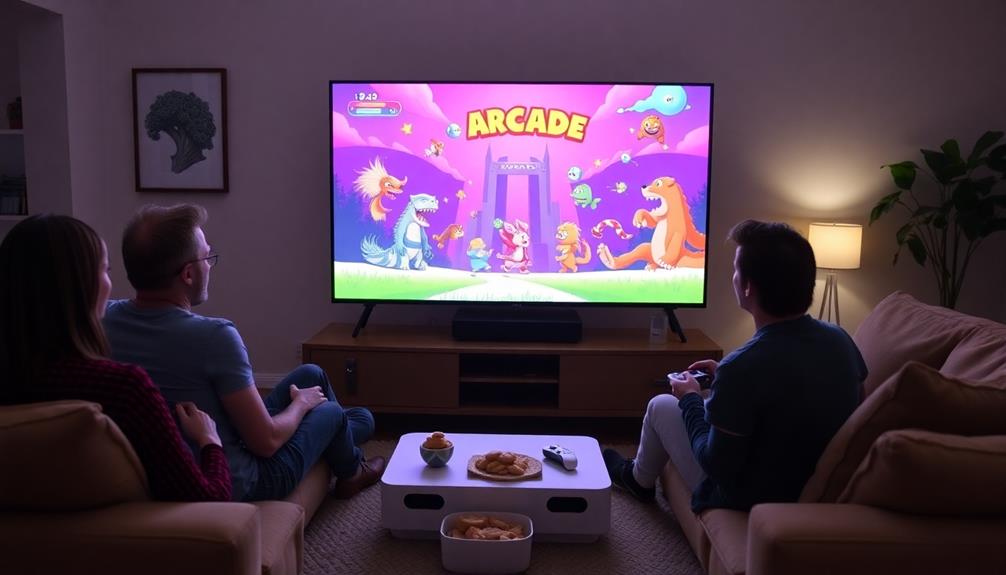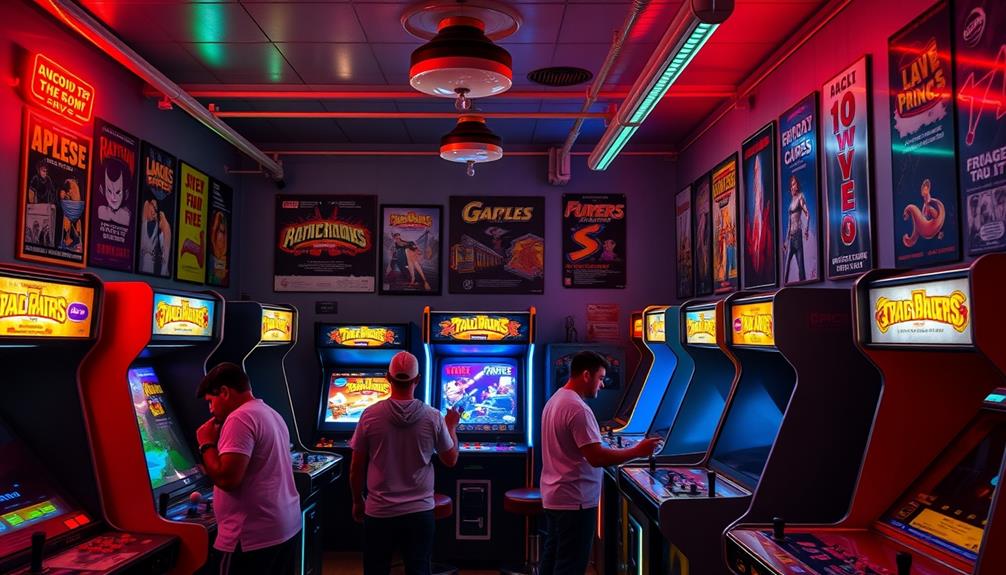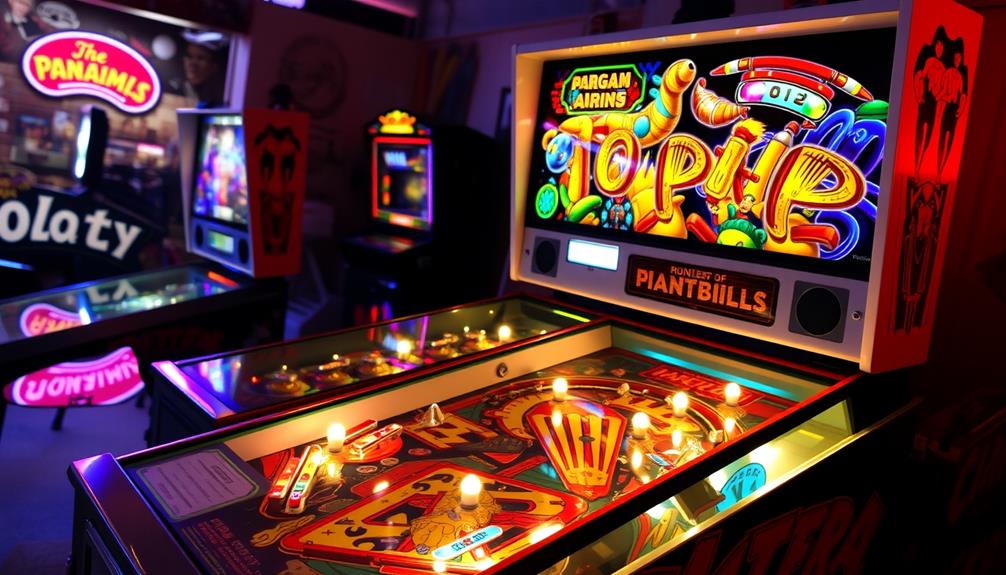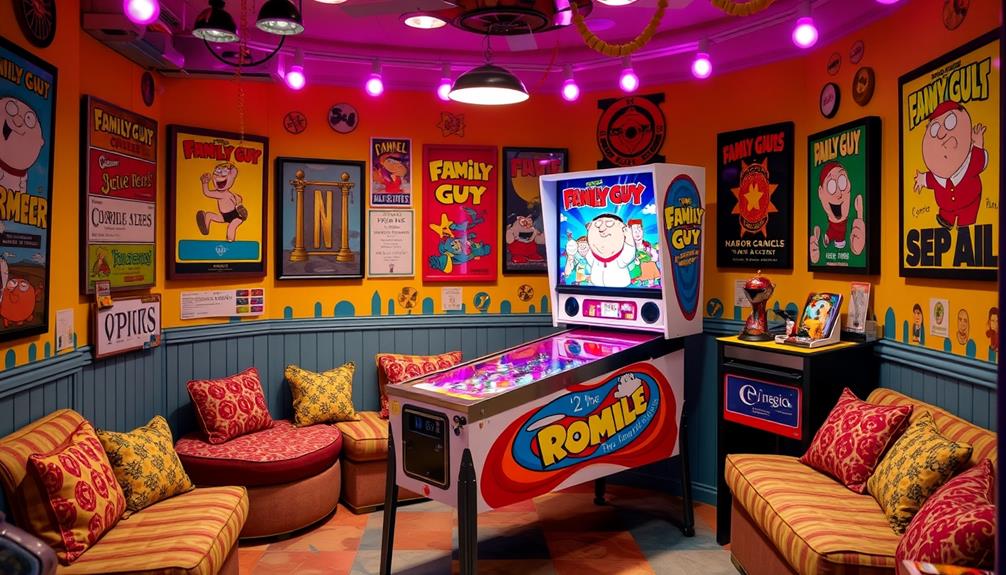Arcade gaming has undergone a significant transformation, resulting in a total of 4,670 titles since its inception in the 1970s. The origins can be traced back to 1971 with the first commercial game, Computer Space. Throughout the years, iconic games like Pac-Man and Space Invaders have been influential in shaping the industry and captivating players’ imaginations. Today, modern arcade games offer innovative gameplay across various genres. They serve as not only games but also social hubs for competition and interaction. If you’re interested in the ongoing success of this entertainment medium, there is much more to learn about its impact and future. Arcade game history is a fascinating journey that has left a lasting impact on popular culture. The continuous development of arcade games has led to advancements in technology and gaming experiences. As new generations discover and embrace the timeless charm of arcade gaming, its history continues to evolve with new innovations and experiences. Arcade game history is an intriguing exploration that sheds light on the impact of arcade gaming on our culture.
Key Takeaways
- There are a total of 4,670 arcade game titles recorded since the arcade industry's inception in the 1970s.
- The first commercial arcade game, Computer Space, was launched in 1971, marking the start of arcade gaming.
- The golden age of arcades occurred in the late 1970s to early 1980s, with over 13,000 arcades in operation in the U.S.
- Iconic games like Pac-Man and Space Invaders have significantly shaped the popularity and evolution of arcade gaming.
- Arcade games span a variety of genres, including action, fighting, racing, puzzle, and rhythm games, appealing to diverse audiences.
Overview of Arcade Games
Arcade games have captivated players since the early 1970s, with a staggering total of 4,670 titles recorded to date. The journey began with the first commercial arcade video game, Computer Space, released in 1971. This marked the start of an exciting era in gaming, where arcade cabinets became the centerpiece of entertainment venues.
In addition to classic titles, modern arcade games have embraced innovative features that enhance gameplay, similar to best rated pinball machines of 2024. You'll find a wide variety of game genres among these titles, including action, racing, and fighting. Each genre offers unique gameplay experiences that keep players coming back for more. These coin-operated arcade machines provide a social environment, allowing you to compete with friends or engage with strangers in a shared gaming experience.
Though traditionally standalone units, some modern arcade games have started to adopt alternative payment methods, making them accessible to a broader audience. The influence of arcade games extends beyond the arcade itself; their development paved the way for home console gaming and continues to shape gaming culture today.
Whether you're drawn to nostalgia or the thrill of competition, arcade games remain an essential part of the gaming landscape.
Historical Development

The evolution of arcade games reflects the changing landscape of entertainment and technology over the decades. It all began with the first arcade game, Computer Space, in 1971, which laid the groundwork for the burgeoning industry. The late 1970s to early 1980s marked the golden age of arcade games, characterized by an explosion of popularity. By the end of this era, over 13,000 arcades operated across the U.S., showcasing the immense appeal of arcade gaming.
However, the rise of home gaming consoles led to significant declines in revenue, dropping from $8.9 billion in 1982 to $4.5 billion in 1984. Notable titles like Space Invaders in 1978 and Pac-Man in 1980 had initially propelled arcade gaming into mainstream culture, but market saturation presented challenges.
Despite these setbacks, the arcade industry began to recover in the mid-1980s. Revenue climbed back to $5.5 billion by 1988, thanks to innovative game manufacturers introducing new genres and motion simulator cabinets.
| Year | Revenue (Billions) | Notable Titles |
|---|---|---|
| 1982 | 8.9 | Space Invaders |
| 1984 | 4.5 | Pac-Man |
| 1988 | 5.5 | Various Emerging |
Notable Arcade Titles

Throughout the history of gaming, several titles have stood out, capturing the hearts of players and shaping the arcade experience. Among these notable arcade titles, Pac-Man reigns supreme as an iconic maze chase game that became a cultural phenomenon after its 1980 release.
Just a couple of years earlier, Space Invaders had already begun to define the fixed shooter genre, selling over 100,000 machines in Japan alone by the end of 1978, making it a cornerstone of the arcade scene. The evolution of arcade games parallels the development of pinball machines, which also saw significant innovations in gameplay and design.
Fast forward to 1991, when Street Fighter II revolutionized the fighting game genre, sparking a competitive arcade culture that paved the way for modern esports.
You can't talk about beloved arcade games without mentioning Galaga, which, released in 1981, is celebrated for its engaging gameplay mechanics and has maintained a loyal following over the years.
Game Genres and Ratings

Many arcade games fall into distinct genres, each offering unique gameplay experiences that cater to different player preferences. The variety within arcade gaming makes it appealing to a wide audience, much like how music therapy enhances emotional well-being through engagement and creativity.
Here are some popular game genres you can find in arcades:
- Action Games: The majority of arcade games fall under this category, featuring fast-paced gameplay and dynamic mechanics.
- Fighting Games: Titles like "Street Fighter" and "Mortal Kombat" challenge players to compete head-to-head, showcasing skill and strategy.
- Racing/Driving Games: Notable titles such as "Daytona USA" and "SEGA Rally Championship" provide thrilling experiences behind the wheel.
- Puzzle and Rhythm Games: These genres offer a different type of challenge, focusing on problem-solving or timing to progress.
To evaluate these arcade games, ratings are essential. Moby Scores typically range from 7.6 to 8.3, based on user feedback and gameplay experience.
With a total of 3,219 recorded arcade video games, the diversity in game genres reflects the evolution of player preferences over time, keeping the arcade machines buzzing with excitement.
Cultural Impact of Arcades

Arcades have shaped gaming culture by fostering social interaction and competition among players.
The variety of games available, from classic machines to modern options, has created a vibrant atmosphere that attracts diverse groups.
You can't help but feel the nostalgia when you think about the iconic games that brought people together and influenced the rise of esports.
These experiences not only created lasting memories but also paved the way for new generations to appreciate the cultural significance of arcade gaming, including the best arcade machines for home game rooms.
Social Interaction and Competition
In bustling public spaces, arcade games create an electric atmosphere where players gather, fostering social interaction and healthy competition. This dynamic environment reflects the importance of creative expression and imagination in art, encouraging players to engage with one another and share their experiences.
You'll find that the unique environment encourages camaraderie among players as they battle for high scores and bragging rights. Here are a few key aspects of this vibrant culture:
- High Score Tracking: Games like Space Invaders made it easy for players to compete, creating a sense of rivalry and community engagement.
- Tournaments: The formation of video game tournaments in the 1980s, like those organized by Twin Galaxies, laid the groundwork for modern esports and competitive gaming.
- Collectible Nature: Enthusiasts often share experiences and compete for high scores in classic arcade titles, further enhancing social interaction.
- Retro Events: The nostalgia for arcade experiences has sparked interest in retro-themed events and arcade bars, becoming popular venues for social gatherings.
Arcade games have transformed into a communal hub where competition thrives, showcasing the enduring appeal of gaming culture.
Whether you're aiming for the leaderboard or just enjoying the atmosphere, there's something special about the connections forged in arcade spaces.
Nostalgia in Gaming Culture
The vivid memories of brightly lit arcade cabinets and the sounds of video game beeps and boops evoke a strong sense of nostalgia for gamers of all ages. You may find yourself reminiscing about the thrill of competing with friends on iconic arcade games, which fostered social interaction and a vibrant gaming culture.
Those bustling arcades weren't just venues; they were community hubs where friendships were formed and rivalries ignited. The rise of personalized gaming experiences, much like the current trend in personalized gifts for 2024, allows players to connect with their favorite titles on a deeper level.
Today, that nostalgia fuels a growing trend in collectible arcade cabinets, allowing you to recreate those cherished experiences at home. Retro-themed titles have also made a comeback, tapping into the allure of classic gameplay while enticing a new generation of gamers.
By visiting arcade bars, you can relive the past while enjoying a fresh take on the arcade experience. This powerful connection to the past highlights how arcade games have greatly impacted community building within gaming culture.
The charm of those retro experiences continues to unite players, reminding you that gaming is about more than just scores; it's about creating memories that last a lifetime.
Influence on Esports Development
Emerging from the vibrant atmosphere of arcade gaming, the competitive landscape of esports has roots deeply embedded in the social interactions and tournaments that took place in these venues. The excitement generated by iconic arcade games like *Mortal Kombat* and *Street Fighter II* laid the groundwork for what we now recognize as esports.
Additionally, the competitive nature of arcade gaming often mirrored the principles of investment strategies, as players sought to improve their skills and achieve higher scores, similar to how investors aim for growth in their portfolios.
Here are four key influences of arcades on esports development:
- Tournaments: Arcade tournaments in the 1980s, organized by groups like Twin Galaxies, established the competitive gaming framework that continues today.
- Community: The social interaction fostered in arcades encouraged players to gather, compete, and form lasting communities, essential for esports growth.
- Nostalgia: Many current esports players draw inspiration from their arcade experiences, fueling their competitive spirit and desire to compete.
- Game Evolution: Iconic arcade games shaped the gaming landscape, influencing modern esports events and competitive structures.
Together, these elements have transformed arcade gaming into a crucial component of the esports phenomenon, creating a legacy that resonates with players across generations.
Technological Advancements

Throughout the history of arcade gaming, technological advancements have drastically transformed the landscape, enhancing both visual appeal and gameplay. You've likely noticed the shift from 2D graphics to stunning real-time 3D visuals, with systems like Sega's Model 1 paving the way. This change marked a significant evolution in how you experience games.
The introduction of AI-driven platforms has also influenced game design, allowing for personalized gaming experiences that cater to diverse player preferences. Game companies like Namco and Sega introduced innovative arcade systems such as Namco System 21 and Sega Model 2, showcasing technological progress through flat-shaded graphics, texture mapping, and shading techniques.
Proprietary hardware platforms like Sega NAOMI have been essential in supporting various arcade titles, allowing for improved game performance and reusability of existing technology. The emergence of multi-game arcade machines has further enhanced reliability and accessibility, making classic experiences more enjoyable for you.
You can also appreciate the spectacle-driven games, like Star Wars Battlepod, which utilize specialized peripherals and hydraulic movements, highlighting the engineering advancements in the industry. These developments not only elevate the gameplay experience but also guarantee that arcade gaming remains a thrilling and engaging pastime.
Future of Arcade Gaming

The future of arcade gaming looks promising as technological innovations are constantly reshaping the experience.
As we explore igniting creativity in a digital world, you can expect a revival of nostalgia-driven designs, bringing back classic titles that appeal to both new players and seasoned veterans.
With these advancements and a nod to the past, arcades are poised to thrive in an evolving entertainment landscape.
Technological Innovations Ahead
As technology continues to advance, arcade gaming is poised for an exciting transformation that promises to enhance player experiences like never before. You can expect a variety of technological innovations that will keep you engaged and entertained, similar to the way top projectors for gaming enthusiasts elevate gaming experiences.
Here are four key trends shaping the future of arcade gaming:
- Multi-game machines: These allow you to enjoy numerous titles in one cabinet, making it easier and more convenient for you to explore different games without switching machines.
- Immersive arcade experiences: With advancements like hydraulic movements and specialized peripherals, you'll find yourself fully immersed in games like Star Wars Battlepod, showcasing innovative engineering.
- Online features: The integration of leaderboards and trading cards fosters competition and community interaction, keeping you connected with fellow players even when you're not at the arcade.
- Home ownership: The resurgence of retro arcade games and the affordability of refurbished machines make it easier for you to recreate the arcade experience at home.
These innovations not only enhance your gaming experience but also illustrate the adaptability of arcades in today's entertainment landscape.
Nostalgia and Retro Revival
Nostalgia is driving a remarkable revival in the arcade scene, as players seek out the familiar thrills of classic games. Retro-themed arcade games are popping up in venues known as "barcades," which cater specifically to adult audiences craving those cherished experiences.
You might remember games like Pac-Man, which has over 30 million downloads, showcasing how these classic arcade titles still resonate with modern gamers.
In Japan, limited home space has kept arcades thriving, contributing considerably to the gaming market. In 2009, they generated a whopping US$6 billion out of a total US$20 billion. This ongoing popularity highlights the community aspect of arcade gaming, as players gather to compete and relive the excitement together.
Modern technology enhances this nostalgic experience, with online leaderboards and trading cards that deepen player engagement. Events like the Champion of Champions showcase the competitive aspect of arcade gaming, drawing in new players and reinforcing the cultural relevance of these retro classics.
Frequently Asked Questions
How Many Types of Arcade Games Are There?
There're numerous types of arcade games, ranging from action-packed shooters to strategic maze chases and rhythmic challenges. Each genre offers unique experiences, ensuring there's something for everyone to enjoy in the vibrant arcade scene.
How Many Arcades Are Left in the US?
With the arcade scene fading like an old photograph, you'll find about 2,000 arcades still operating in the U.S. today. Many have pivoted towards family fun, hoping to capture today's gaming audience.
How Many Mame Games Exist?
You'll find MAME supports over 37,000 unique games, including both official titles and unofficial clones. This vast library showcases the rich history of arcade gaming, constantly updated to reflect ongoing preservation efforts.
Do Arcade Games Still Exist?
You'd be surprised to find arcade games still thrive. Despite challenges, you can enjoy them in modern venues like arcade bars. Nostalgia fuels interest, keeping these classic experiences alive and inviting new players to join.
Conclusion
As you explore the vibrant world of arcade games, it's clear that their legacy is far-reaching and ever-evolving. With countless titles and genres to experience, how can you resist diving into the nostalgia and excitement they offer? From the pixelated classics that shaped gaming history to the cutting-edge innovations of today, arcades continue to captivate players of all ages. So, grab a joystick, and immerse yourself in the thrilling adventure that awaits in every arcade!









